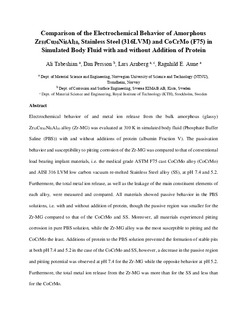| dc.contributor.author | Tabeshian, Ali | |
| dc.contributor.author | Persson, Dan | |
| dc.contributor.author | Arnberg, Lars | |
| dc.contributor.author | Aune, Ragnhild Elizabeth | |
| dc.date.accessioned | 2019-04-02T06:59:37Z | |
| dc.date.available | 2019-04-02T06:59:37Z | |
| dc.date.created | 2018-12-10T20:21:15Z | |
| dc.date.issued | 2018 | |
| dc.identifier.citation | Materials and corrosion - Werkstoffe und Korrosion. 2018, 1-9. | nb_NO |
| dc.identifier.issn | 0947-5117 | |
| dc.identifier.uri | http://hdl.handle.net/11250/2592804 | |
| dc.description.abstract | Electrochemical behavior of, and metal ion release from the bulk amorphous (glassy) Zr55Cu30Ni5Al10 alloy (Zr‐MG) was evaluated in simulated body fluid (phosphate buffer saline [PBS]), with and without additions of protein (albumin Fraction V) at pH 7.4 and 5.2 and at body temperature 310 K (37 °C). The passivation behavior and susceptibility to pitting of the Zr‐MG was compared with conventional load bearing implant materials, that is, the medical grade ASTM F75 cast CoCrMo alloy (CoCrMo) and AISI 316 LVM low carbon vacuum re‐melted stainless steel alloy (SS). Furthermore, the metal ion release from the main constituent elements of each alloy was measured and compared. All materials showed passive behavior in the PBS solution with and without presence of albumin, though the passive region was smaller for the Zr‐MG compared to the CoCrMo and SS. Moreover, all materials experienced pitting corrosion in the PBS solution while the Zr‐MG was the most susceptible and the CoCrMo was the least one. Protein additions to the CoCrMo and SS prevented the formation of stable pits at pH 7.4 and 5.2. A decrease in passive region and pitting potential was seen in the case of albumin additions for the Zr‐MG at pH 7.4, while the opposite was seen at pH 5.2. Furthermore, the total metal ion release from the Zr‐MG was less than for the CoCrMo. | nb_NO |
| dc.language.iso | eng | nb_NO |
| dc.publisher | Wiley | nb_NO |
| dc.title | Comparison of the electrochemical behavior of amorphous Zr55Cu30Ni5Al10, stainless steel (316LVM), and CoCrMo (F75) in simulated body fluid with and without addition of protein | nb_NO |
| dc.type | Journal article | nb_NO |
| dc.type | Peer reviewed | nb_NO |
| dc.description.version | acceptedVersion | nb_NO |
| dc.source.pagenumber | 1-9 | nb_NO |
| dc.source.journal | Materials and corrosion - Werkstoffe und Korrosion | nb_NO |
| dc.identifier.doi | 10.1002/maco.201810480 | |
| dc.identifier.cristin | 1641375 | |
| dc.description.localcode | Locked until 15 October 2019 due to copyright restrictions. This is the peer reviewed version of an article, which has been published in final form at https://doi.org/10.1002/maco.201810480. This article may be used for non-commercial purposes in accordance with Wiley Terms and Conditions for Self-Archiving. | nb_NO |
| cristin.unitcode | 194,66,35,0 | |
| cristin.unitname | Institutt for materialteknologi | |
| cristin.ispublished | true | |
| cristin.fulltext | postprint | |
| cristin.qualitycode | 1 | |
